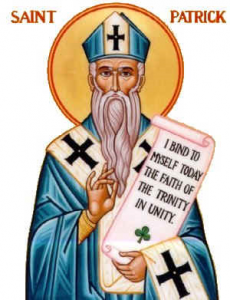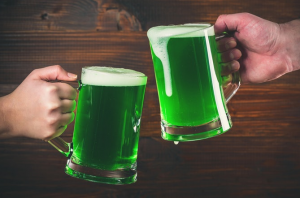 Most of us think of Saint Patrick’s day as a day to celebrate being Irish, and to celebrate even if you aren’t Irish. But this day is actually dedicated to a man who was considered legendary by the Irish people. Born in Great Britain, probably in Scotland, to a well-to-do Christian family of Roman citizenship, Patrick was captured and enslaved at age 16 by Irish marauders. For the next six years, he worked as a herder in Ireland, turning to a deepening religious faith for comfort. Following the counsel of a voice he heard in a dream one night, he escaped and found passage on a ship to Britain, where he was eventually reunited with his family.
Most of us think of Saint Patrick’s day as a day to celebrate being Irish, and to celebrate even if you aren’t Irish. But this day is actually dedicated to a man who was considered legendary by the Irish people. Born in Great Britain, probably in Scotland, to a well-to-do Christian family of Roman citizenship, Patrick was captured and enslaved at age 16 by Irish marauders. For the next six years, he worked as a herder in Ireland, turning to a deepening religious faith for comfort. Following the counsel of a voice he heard in a dream one night, he escaped and found passage on a ship to Britain, where he was eventually reunited with his family.
Much of what is known about Patrick’s legendary life comes from a book he wrote during his last years, called the Confessio. According to the Confessio, while in Britain, Patrick had another dream, in which an individual named Victoricus gave him a letter. The letter was entitled “The Voice of the Irish.” As he read it, Patrick seemed to hear the voices of Irishmen pleading him to return to their country and walk among them once more. After studying for the priesthood, Patrick was ordained a bishop. He arrived in Ireland in 433 and began preaching the Gospel, converting many thousands of Irish and building churches around the country. After 40 years of living in poverty, teaching, traveling, and working tirelessly, Patrick died on March 17, 461 in Saul,  where he had built his first church.
where he had built his first church.
Since Patrick’s passing, countless legends have grown up around him. The Irish made him the patron saint of Ireland. They say he baptized hundreds of people on a single day, and that he used a three-leaf clover…the famous shamrock…to describe the Holy Trinity. He is often portrayed in art as trampling on snakes, a picture that came with the belief that he drove those reptiles out of Ireland. For thousands of years, the Irish have observed the day of Saint Patrick’s death as a religious holiday, attending church in the morning and celebrating with food and drink in the afternoon. It was a day to be thankful for the man who bought them to the Lord. As holidays often do, the ways of celebrating changed over the years. The first St. Patrick’s Day parade took place not in Ireland, but the United States, when Irish soldiers serving in the English military marched through New York City in 1762. I’m sure they were doing their best to keep with the tradition of their country. As the years went on, the parades became a show of unity and strength for persecuted Irish-American  immigrants, and then a popular celebration of Irish-American heritage.
immigrants, and then a popular celebration of Irish-American heritage.
The rest of the world observed it differently…probably due to the Irish tourism’s efforts to promote their country. The party went global in 1995, when the Irish government began a large-scale campaign to market Saint Patrick’s Day as a way of driving tourism and showcasing Ireland’s many charms to the rest of the world. Today, March 17 is a day of international celebration, as millions of people around the globe put on their best green clothing to drink beer, watch parades and toast the luck of the Irish, but it was never really about luck, you know…it was about blessing. Happy Saint Patrick’s day…and cheers!!


Leave a Reply